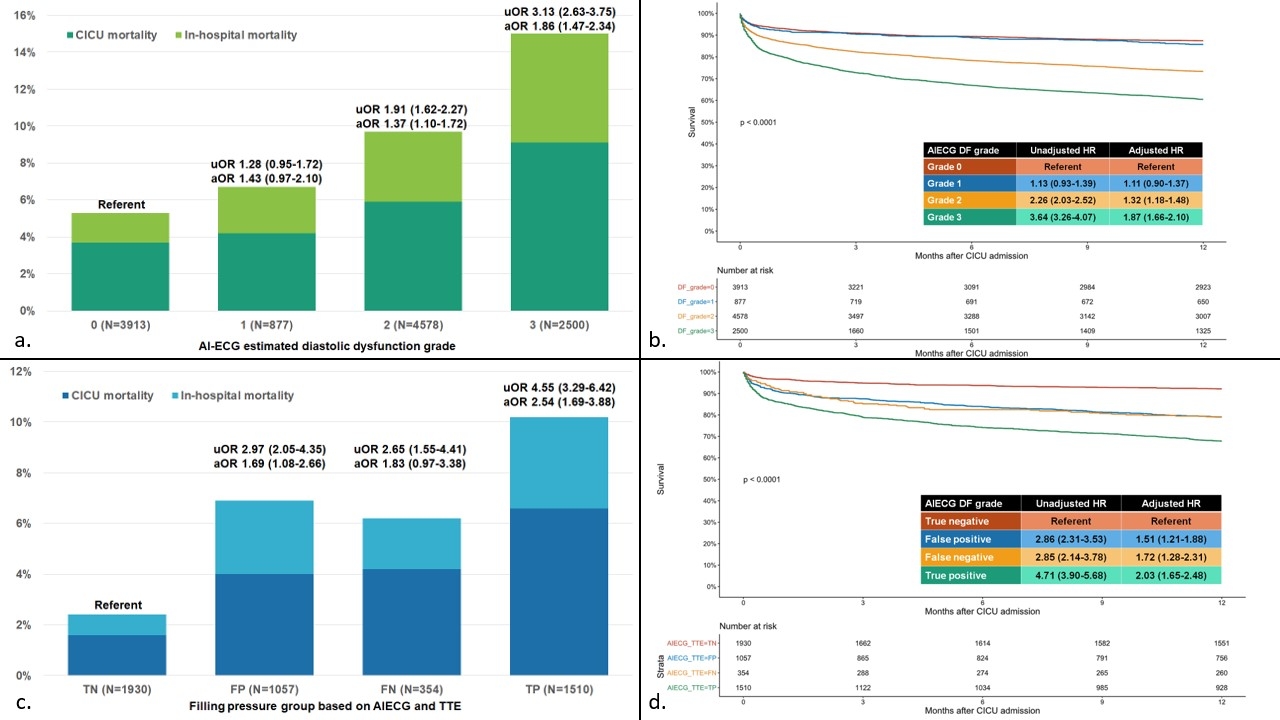Final ID: MDP1527
Artificial Intelligence Assessment of Diastolic Dysfunction by Electrocardiogram: Outcomes in Cardiac Intensive Care Unit Patients
Abstract Body (Do not enter title and authors here): Background
Left ventricular diastolic dysfunction (LVDD) predicts mortality in cardiac intensive care unit (CICU) patients. A novel artificial intelligence enhanced electrocardiogram (AIECG) algorithm can predict LVDD and mortality in general populations but has not been examined in the cardiac intensive care unit (CICU). We aim to assess if LVDD by AI-ECG is associated with in-hospital and one-year mortality in CICU patients.
Methods
In this retrospective cohort study, we included consecutive unique adults admitted to the Mayo Clinic CICU from 2007 to 2018 with an admission AIECG, which AI assigned LVDD grade (0 to 3). Medial mitral E/e’ ratio >15 on transthoracic echocardiogram (TTE) defined elevated filling pressures. AIECG and TTE assessment of LVDD were used to assign patients to four groups based on TTE as gold standard: true and false negative, and true and false positive. In-hospital mortality was evaluated using multivariable logistic regression. One-year survival was evaluated using Kaplan-Meier curves and multivariable Cox proportional-hazards.
Results
We included 11,868 patients (median age 69.5 years, 37.7% females); 48% had heart failure and 44% had acute coronary syndromes. AIECG LVDD grades were: grade 0 (normal), 33%; grade 1, 7%; grade 2, 39%; grade 3, 21%. In-hospital (adjusted OR) and one-year (adjusted HR) mortality increased in each higher AIECG LVDD grade (Figure A/B), before and after adjustment including TTE measurements. Patients with grade 2-3 LVDD by AIECG and medial mitral E/e’ ratio >15 by TTE (true positive) had the highest in-hospital (adjusted OR 2.5 [1.7-3.9]) and one-year (adjusted HR 1.9 [1.5-2.5]) mortality (Figure C/D), and mortality was elevated similarly in patients with either grade 2-3 LVDD by AIECG (false positive) or medial mitral E/e’ ratio >15 by TTE (false negative).
Conclusions
The AIECG LVDD grade was strongly associated with in-hospital and one-year mortality in CICU patients, even after adjusting for clinical variables and TTE measurements. Patients with concordant AIECG and TTE for elevated filling pressures (true positive) were at highest risk.
Left ventricular diastolic dysfunction (LVDD) predicts mortality in cardiac intensive care unit (CICU) patients. A novel artificial intelligence enhanced electrocardiogram (AIECG) algorithm can predict LVDD and mortality in general populations but has not been examined in the cardiac intensive care unit (CICU). We aim to assess if LVDD by AI-ECG is associated with in-hospital and one-year mortality in CICU patients.
Methods
In this retrospective cohort study, we included consecutive unique adults admitted to the Mayo Clinic CICU from 2007 to 2018 with an admission AIECG, which AI assigned LVDD grade (0 to 3). Medial mitral E/e’ ratio >15 on transthoracic echocardiogram (TTE) defined elevated filling pressures. AIECG and TTE assessment of LVDD were used to assign patients to four groups based on TTE as gold standard: true and false negative, and true and false positive. In-hospital mortality was evaluated using multivariable logistic regression. One-year survival was evaluated using Kaplan-Meier curves and multivariable Cox proportional-hazards.
Results
We included 11,868 patients (median age 69.5 years, 37.7% females); 48% had heart failure and 44% had acute coronary syndromes. AIECG LVDD grades were: grade 0 (normal), 33%; grade 1, 7%; grade 2, 39%; grade 3, 21%. In-hospital (adjusted OR) and one-year (adjusted HR) mortality increased in each higher AIECG LVDD grade (Figure A/B), before and after adjustment including TTE measurements. Patients with grade 2-3 LVDD by AIECG and medial mitral E/e’ ratio >15 by TTE (true positive) had the highest in-hospital (adjusted OR 2.5 [1.7-3.9]) and one-year (adjusted HR 1.9 [1.5-2.5]) mortality (Figure C/D), and mortality was elevated similarly in patients with either grade 2-3 LVDD by AIECG (false positive) or medial mitral E/e’ ratio >15 by TTE (false negative).
Conclusions
The AIECG LVDD grade was strongly associated with in-hospital and one-year mortality in CICU patients, even after adjusting for clinical variables and TTE measurements. Patients with concordant AIECG and TTE for elevated filling pressures (true positive) were at highest risk.
More abstracts on this topic:
Artificial Intelligence-Enabled Electrocardiogram for the Detection of Elevated Filling Pressure in Hypertrophic Cardiomyopathy and Cardiac Amyloidosis
Van Lerberghe Robin, Grogan Martha, Friedman Paul, Herrmann Joerg, Janssens Stefan, Vandenberk Bert, Jacobs Johanna, Servaes Veerle, Robyns Tomas, Van Aelst Lucas, Mangold Kathryn, Attia Zachi, Oh Jae
A Multicenter Study of Detection of Pulmonary Hypertension Based on Point-of-Care 12- Lead ECG DataDubrock Hilary, Wieczorek Mikolaj, Hackett Sarah, Alger Heather, Carlson Katherine, Klugherz Paul, Carter Rickey, Wagner Tyler, Johnson Patrick, Frantz Robert, Strom Jordan, Waks Jonathan, Agarwal Richa, Hemnes Anna, Steinberg Benjamin, Pandey Ambarish

